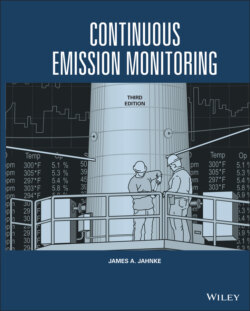Читать книгу Continuous Emission Monitoring - James A. Jahnke - Страница 14
Extractive Systems
ОглавлениеExtractive gas monitoring systems were the first to be developed for source measurements. In these systems, gas is extracted from a duct or stack and transported to analyzers to measure the pollutant concentrations. Many of the early extractive systems first diluted the gas using rotameters, and then applied ambient air analyzers for measurements. However, frequent problems occurred in maintaining stable dilution ratios, so analyzers were subsequently developed to directly measure the flue gas at source‐level concentrations in the range of 100–1000 ppm or higher. These source‐level extractive systems were quite successful and received their widest application in the 1970s and early 1980s.
Many of the problems associated with the earlier dilution systems have since been eliminated by new techniques developed in the 1980s. The advent of the “dilution probe” made dilution systems viable for source measurements. Dilution systems are now relatively easy to construct and exhibit good performance. They are particularly useful for monitoring water‐soluble gases and provide a platform for the application of a new generation of analyzers that are able to measure part per billion concentration levels.
In order for an instrument to measure gas concentrations, the gas sample must be free of particulate matter. Often, water vapor is removed and the sample is cooled to instrument temperature. This requires the use of valves, pumps, chillers, sample tubing, and other components necessary for gas transport and conditioning. “Hot‐wet” systems, which measure hot gases without water removal, operate continuously at elevated temperatures, eliminating the need for water removal systems. Extractive systems use an umbilical line to transport the flue gas sample from the stack or duct to an analyzer cabinet or temperature‐controlled shelter. This line is heated in source‐level systems where the conditioning system is located in the shelter.
Figure 1‐2 Types of monitoring systems.
Dilution‐extractive systems became popular in the 1990s for determining pollutant mass emission rates at U.S. coal‐fired power plants subject to acid rain cap‐and‐trade regulations. Dilution‐extractive CEM systems measure on a wet basis, an advantage when required to report emissions in units of tons/year or kg/hr. Dilution‐extractive systems are available where the sample dilution takes place in a specially designed in‐stack probe or, alternatively, in a probe box outside of the stack, where a variety of dilution techniques are available. In either case, when the flue gas sample is diluted at the stack, a heated umbilical line is not always needed to transport the diluted sample to a CEM shelter.
Close‐coupled systems are extractive systems where the sample conditioning and analysis are conducted directly on the stack. In these systems, the analyzer is connected directly to the sample probe. These systems avoid sample losses for “sticky” or reactive gases due to gas transport and also reduce system costs by not requiring an umbilical line.
